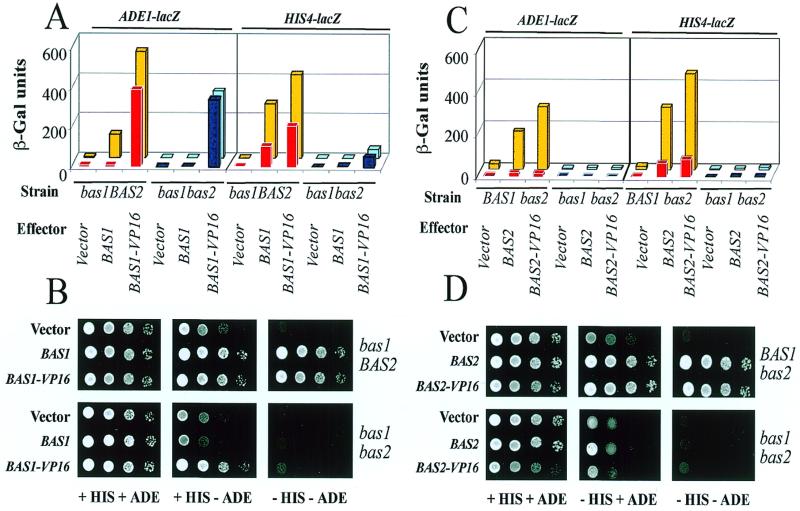Figure 4.
Binding of Bas1p or Bas2p to promoters in vivo monitored by VP16 fusions. (A) Activation of ADE1–LacZ or HIS4–LacZ fusions by Bas1p–VP16 in vivo. Yeast cells were co-transformed with a plasmid carrying the LacZ fusion and a plasmid carrying one of the following genes: BAS1 (P79), BAS1–VP16 (B184) or the corresponding empty vector (B836). Transformed cells were grown in the presence (red and dark blue boxes) or absence (yellow or light blue boxes) of adenine and β-Gal assays were performed as described in Materials and Methods. (B) Activation of ADE or HIS genes by Bas1p–VP16 in vivo. Y329 (bas1BAS2) and L4233 (bas1bas2) cells were transformed with either the empty control plasmid or plasmids carrying the wild-type or VP16 version of the BAS1 gene and were treated as described in the legend to Figure 1B. (C) Activation of ADE1–LacZ or HIS4–LacZ fusions by Bas2p–VP16 in vivo. Yeast cells were co-transformed with a plasmid carrying the LacZ fusion and a plasmid carrying one of the following genes: BAS2 (P1262), BAS2–VP16 (18) or the corresponding empty vector Ycplac111. Transformed cells were grown in the presence (red and dark blue boxes) or absence (yellow or light blue boxes) of adenine and β-Gal assays were performed as described in Materials and Methods. (D) Activation of ADE or HIS genes by Bas2p–VP16 in vivo. Y330 (BAS1bas2) and L4233 (bas1bas2) cells were transformed with either the empty control plasmid or plasmids carrying the wild-type or VP16 version of the BAS2 gene and were treated as described in the legend to Figure 1B.

